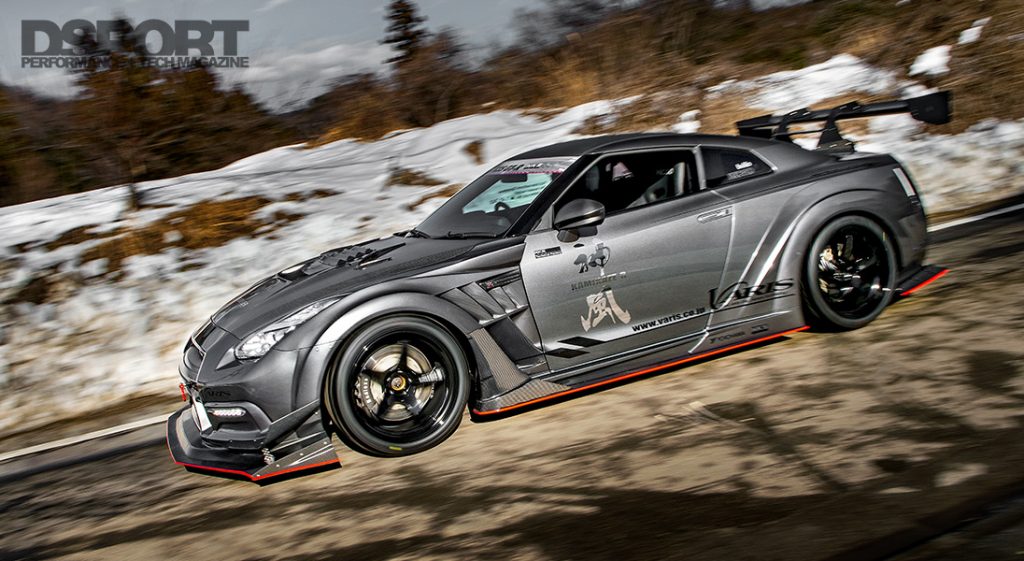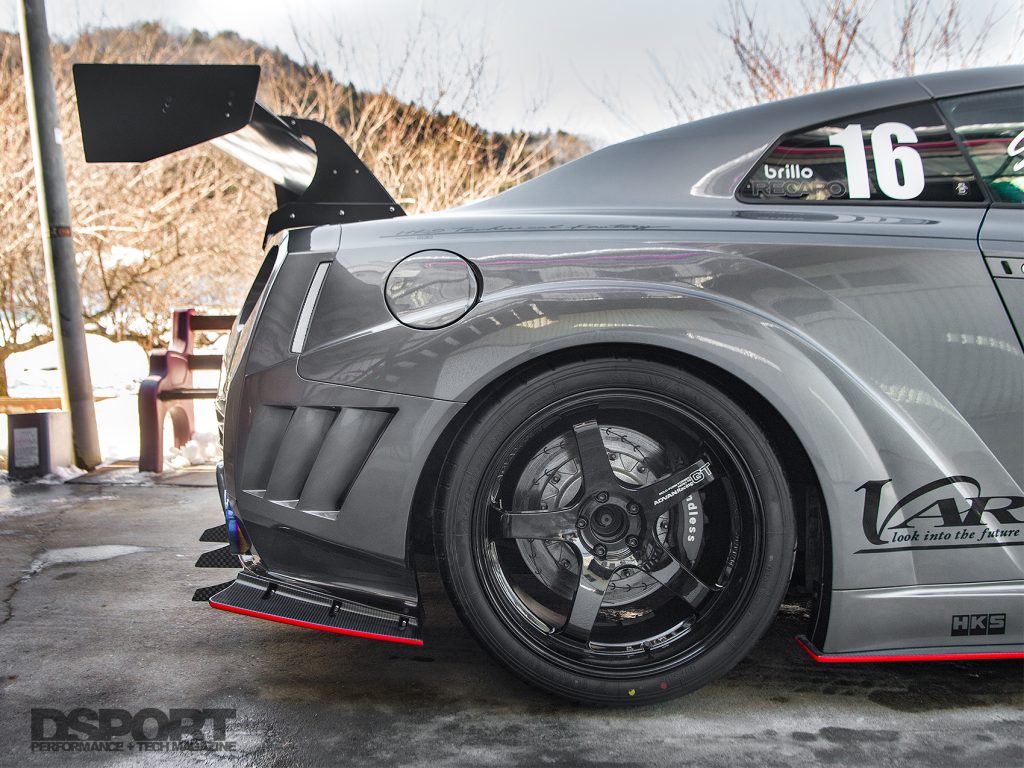Real track killers look fast because they are fast. In speed contests of any type, function ends up dictating fashion, never the other way around. Varis Corporation, based out of Japan’s Kanagawa Prefecture, has made a name for itself by creating functional aerodynamic solutions created from and informed by research and experience in Super GT and Super Endurance racing series. These trials by fire led to the creation of the Kamikaze-R aero kit for the venerable Nissan R35 GT-R. With this direct-from-racing heritage, constant data acquisition necessitates constant revision; the Kamikaze-R Version 2 is the latest iteration of their top-line widebody package.
Text by Arnold Eugenio // Photos by Rob Shaw
DSPORT Issue #187
In the Beginning
This 2008 platform first underwent Kamikaze surgery in 2013 when the original aero parts were designed. As Varis holds the “function as fashion” ideal as one of its core tenets, the kit was designed to maximize handling capabilities of the R35. In 2016, the car underwent additional performance mods that needed aero support, creating the wide-body track kira seen here.
Tried and True
When an aero company needs to track test aero gear on a 1,000-plus-horsepower monster, being able to hold and maintain the power level is as important as getting to that level. With that in mind, NAPREC fortified the VR38DETT’s rotating innards with components from HKS; an HKS stroker crankshaft mates to a sextet of HKS’ H-beam connecting rods, and each of those is topped with HKS forged slugs in the 9.0:1-compression variety. The resulting 95.5mm-squared configuration increases engine displacement to 4,100cc.
Head Massage
The increased air flow capabilities of the bottom end were matched with equivalent cylinder head modifications including combustion chamber matching, port expansion and multi-angle valve seating. Upgraded valve springs complement the high-lift (11mm) HKS camshafts. These feature 270-degree (intake) and 278-degree (exhaust) durations to maximize available combustion chamber oxygen for power production. A pair of 0.8mm-thick head gaskets from HKS seal everything together. The upgraded rotating assembly and valvetrain combine to allow a powerband extension peak through the 7,400 RPM shift point.
(L) HKS intake piping runs the full gamut from the air filter intake, through the GT1000 intercooler, and into the factory intake chambers. (R) The carbon-fiber hood has facilities to duct air into and vent air from the engine bay.
Brave Hearts
 The centerpieces of the power production are the symmetrical HKS GTII 7867 turbochargers. The opposing-rotation turbochargers lend themselves to symmetrically-mirrored layouts and orientations; an advantage best exploited by the VR’s V6 configuration. The turbines are fed cold air ingested through HKS intake filters and temp-reduced through an HKS GT 1000 intercooler kit; a symmetrically paired, dual-core, vertical configuration that’s said to provide equal cooling to left and right intake banks. Boost moderating duties belong to a pair of HKS GTII wastegates that, along with the EVC VI boost controller, limit maximum boost pressure to 1.9 kg/cm2 (approximately 27psi). A pair of HKS Sequential Blow-off Valves control compressor surge.
The centerpieces of the power production are the symmetrical HKS GTII 7867 turbochargers. The opposing-rotation turbochargers lend themselves to symmetrically-mirrored layouts and orientations; an advantage best exploited by the VR’s V6 configuration. The turbines are fed cold air ingested through HKS intake filters and temp-reduced through an HKS GT 1000 intercooler kit; a symmetrically paired, dual-core, vertical configuration that’s said to provide equal cooling to left and right intake banks. Boost moderating duties belong to a pair of HKS GTII wastegates that, along with the EVC VI boost controller, limit maximum boost pressure to 1.9 kg/cm2 (approximately 27psi). A pair of HKS Sequential Blow-off Valves control compressor surge.
Blood In, Blood Out
The increased oxygen supplied to the system needs a corresponding and appropriate increase in fuel supplied to safely create the rated power output. To that end, three HKS fuel pumps feed twelve Nissan 575cc fuel injectors. Combustion chamber ignition is initiated through HKS M45HL iridium spark plugs with a NEKO engine management system orchestrating the air-fuel-ignition events. On a DynoJet, the stroked VR engine put down 1,063ps (approx. 1,048bhp).
The Down Sides
 To fully exploit the chassis’ handling capabilities, mechanical grip and suspension components must work together with aero. The upgrade here starts with a set of HKS Hipermax IV adjustable dampers that control both ride-height and compression/rebound characteristics of the installed HKS 18kg/mm2 rated suspension springs. A set of ADVAN Racing GT wheels, sized at 20 x 11 inches all the way around, help reduce rotating mass over the factory alloys while wearing the ADVAN A08B 285/35 rubbers to complete the mechanical side of the grip equation. Stopping power is provided by a set of Endless Racing 6-piston monoblock calipers squeezing Endless Racing competition brake pads on all four corners.
To fully exploit the chassis’ handling capabilities, mechanical grip and suspension components must work together with aero. The upgrade here starts with a set of HKS Hipermax IV adjustable dampers that control both ride-height and compression/rebound characteristics of the installed HKS 18kg/mm2 rated suspension springs. A set of ADVAN Racing GT wheels, sized at 20 x 11 inches all the way around, help reduce rotating mass over the factory alloys while wearing the ADVAN A08B 285/35 rubbers to complete the mechanical side of the grip equation. Stopping power is provided by a set of Endless Racing 6-piston monoblock calipers squeezing Endless Racing competition brake pads on all four corners.
Forward Mobility
The GR6-based drivetrain in the R35 can withstand a significant amount of punishment, but will eventually succumb to the laws of physics after repeated and extended hard use. To this end, an HKS transmission upgrade service was performed. This includes larger cogs with ceramic-coating treatments, replacement sandwich plates capable of enduring greater loads, and upgraded output shafts. HKS rates the power-handling ability of the transmission upgrade adequate for platforms making up to 1,200bhp.
Complementing the transmission upgrade, an HKS clutch pack upgrade also helps ensure the power gets to the ground. This is accomplished through an increase in the number of clutch disc plates as well as the use of proprietary disc material. In the GR6 transmission, torque is transferred through the factory driveshaft and a NISMO LSD, further aiding the Nissan’s torque-vectoring distribution ability.
Suit and Tie
The centerpiece of the build is the resulting aero. This second version of the original Kamikaze-R is a multi-piece kit based on the wide-body aspect. Front and rear fender flares are styled to allow the performance benefits of running a wider wheel-and-tire combination while adding much-needed air-evacuating venting. The front bumper, lip and canards increase downforce and provide high-velocity air feeds for engine ingestion and cooling. The hood venting creates a vacuum at speed that aids in evacuating hot engine-bay air and increasing flow-through from the front-facing venting.
The front lip and side skirting combine to maximize aero-induced downforce by increasing the vacuum created underneath the vehicle. Rear exit air spoiling ensures undercar air has the most efficient flow path while the ever-present rear wing provides another aerodynamically-induced surface that increases rear downforce and helps stabilize lateral movement at high speeds. Cosmetic enhancements for the aero kit include model-year 2014 Nissan OE lights and Valenti LED taillights to replace the iconic GT-R filament-bulb units.
A pair of Recaro seats occupies the space under the custom Saito rollcage.
Inner Sanctum
The interior features the standard race-car accoutrements including a pair of Recaro RS-G seats that utilize Willans harnesses to keep occupants in place. A Nardi steering wheel provides direct control of the all-wheel-drive beast that boasts an 11.07-second 0-400 meter time and a fast lap of 1:41.743-seconds at the Fuji Speedway circuit.
The HKS Circuit Attack Counter allows the driver to monitor top speeds, lap times, and other information pertinent to the design and testing process.
End Notes
While the aero development process necessitated a powerful platform upon which to hang the wares, it was still a welcome surprise to the Varis team to be rewarded for the build at the Tokyo International Custom Car Contest. With a never-ending research and development cycle, it’s just a matter of time before we see the next killer build from Varis.













